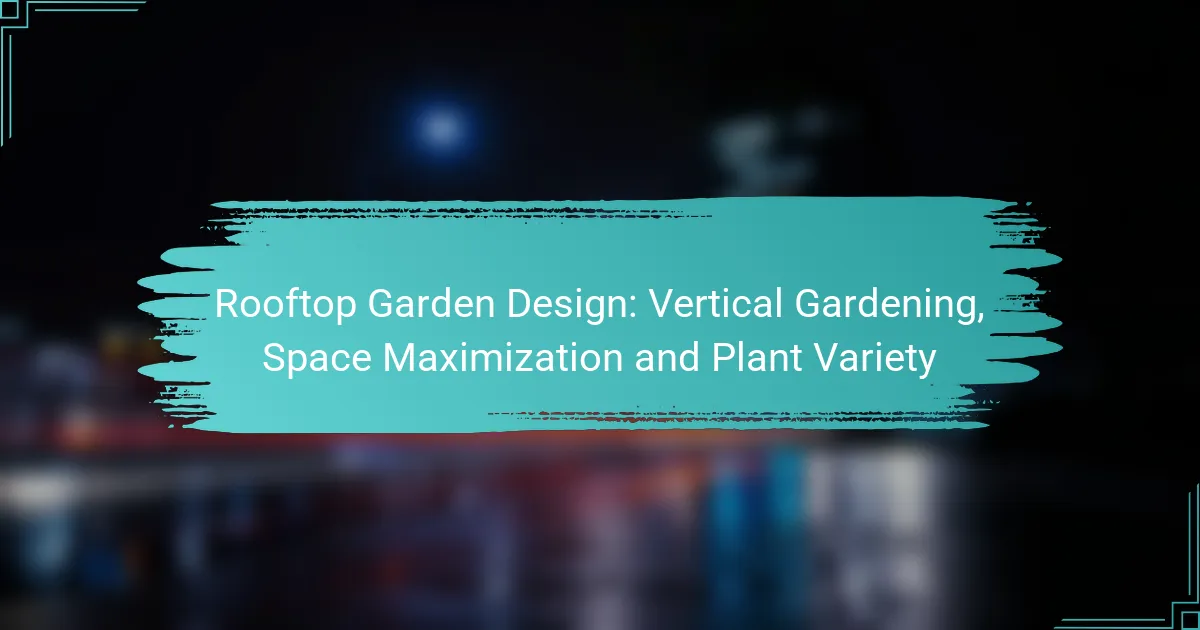Designing a rooftop garden in urban environments requires careful planning to maximize limited space while creating a functional and visually appealing oasis. Utilizing vertical gardening techniques not only optimizes area but also encourages a diverse range of plants that can thrive in confined settings. By selecting the right plants and incorporating space-saving furniture, you can transform your rooftop into a vibrant green retreat.
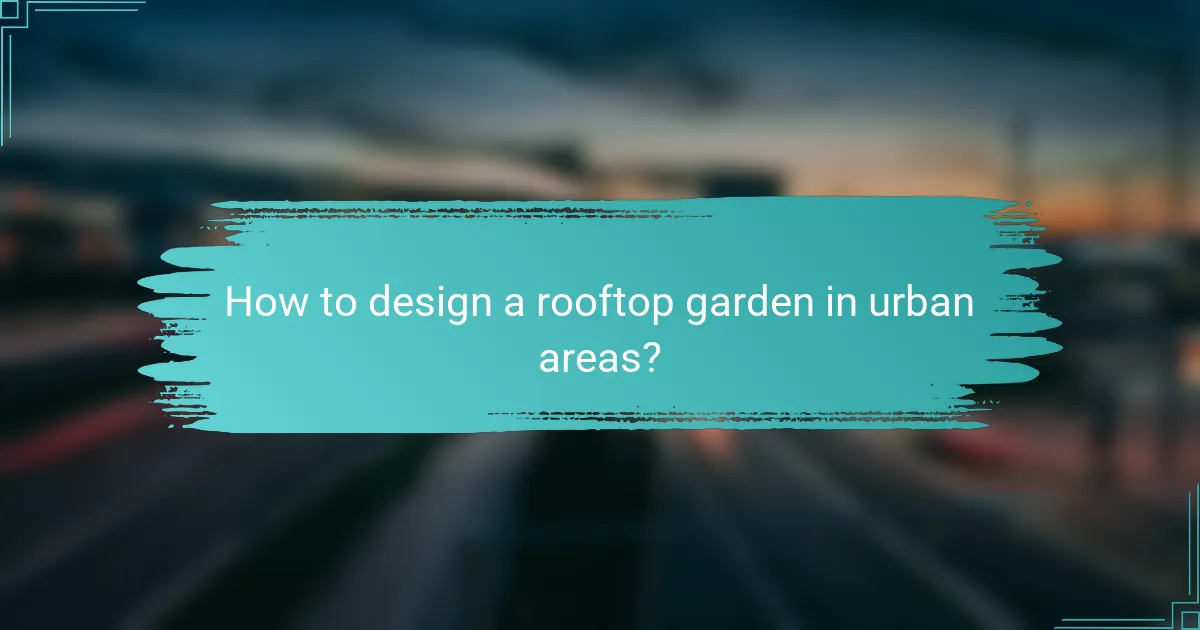
How to design a rooftop garden in urban areas?
Designing a rooftop garden in urban areas involves maximizing limited space while ensuring the garden is functional and aesthetically pleasing. Key considerations include vertical gardening techniques, space-saving furniture, and selecting appropriate plants that thrive in confined environments.
Utilize vertical gardening techniques
Vertical gardening techniques allow you to make the most of limited rooftop space by growing plants upwards rather than outwards. Options include wall planters, trellises, and vertical garden systems that can support a variety of plants.
Consider using modular systems that can be easily rearranged or expanded as your garden grows. This flexibility can help you adapt to changing sunlight conditions and plant needs throughout the seasons.
Incorporate space-saving furniture
Choosing space-saving furniture is essential for creating a functional rooftop garden. Look for foldable or stackable chairs and tables that can be easily stored when not in use, allowing for more room for plants.
Additionally, consider multi-functional furniture, such as benches with built-in storage for gardening tools or cushions that double as planters. This approach maximizes utility without sacrificing comfort.
Choose lightweight soil alternatives
Using lightweight soil alternatives is crucial for rooftop gardens, as traditional soil can be too heavy for structural integrity. Options like coconut coir, perlite, and vermiculite provide good drainage and aeration while reducing weight.
Mixing these materials can create a balanced growing medium that retains moisture without becoming overly heavy. Aim for a soil mix that is about 30-50% lightweight components to ensure optimal plant growth.
Implement irrigation systems
Efficient irrigation systems are vital for maintaining a rooftop garden, especially in urban areas where water access may be limited. Drip irrigation or self-watering systems can provide consistent moisture to plants without excessive water waste.
Consider installing a rainwater collection system to utilize natural resources and reduce water costs. This sustainable approach can be particularly beneficial in regions with variable rainfall patterns.
Select suitable plants for limited space
Choosing the right plants is essential for a successful rooftop garden in urban settings. Opt for compact varieties of vegetables, herbs, and flowers that thrive in smaller spaces, such as dwarf tomatoes, basil, and marigolds.
Additionally, consider the local climate and sunlight conditions when selecting plants. Native species often require less maintenance and are better adapted to urban environments, making them a practical choice for rooftop gardens.
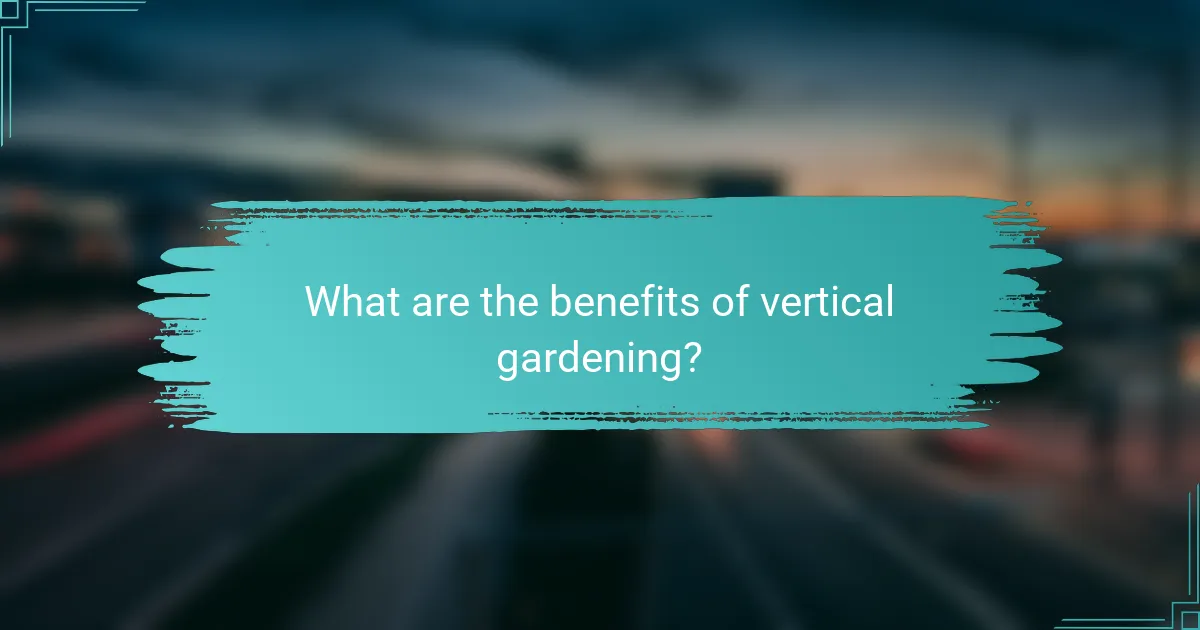
What are the benefits of vertical gardening?
Vertical gardening offers numerous advantages, particularly for urban dwellers with limited space. It allows for efficient use of available area while promoting plant diversity and improving environmental conditions.
Maximizes limited space
Vertical gardening is an effective solution for maximizing small outdoor or indoor spaces. By utilizing vertical structures, such as trellises, wall planters, or hanging pots, gardeners can grow a variety of plants without requiring extensive ground area.
Consider using modular systems that can be adjusted to fit various spaces, whether it’s a balcony, rooftop, or even a small backyard. This approach allows for creative layouts that can accommodate different plant types and sizes.
Improves air quality
Plants in vertical gardens contribute to better air quality by absorbing carbon dioxide and releasing oxygen. This natural process helps to filter pollutants and can significantly enhance the atmosphere in urban environments.
Incorporating a mix of plants known for their air-purifying qualities, such as spider plants and peace lilies, can further improve indoor air conditions. Regular maintenance, including watering and pruning, ensures that the plants remain healthy and effective in their role.
Enhances aesthetic appeal
Vertical gardens can transform dull spaces into vibrant green areas, adding visual interest and beauty. The variety of colors, textures, and shapes of plants creates a dynamic display that can serve as a focal point in any environment.
When designing a vertical garden, consider using a mix of flowering plants, foliage, and herbs to create a visually appealing arrangement. This not only enhances aesthetics but can also provide fresh herbs for cooking, combining beauty with functionality.
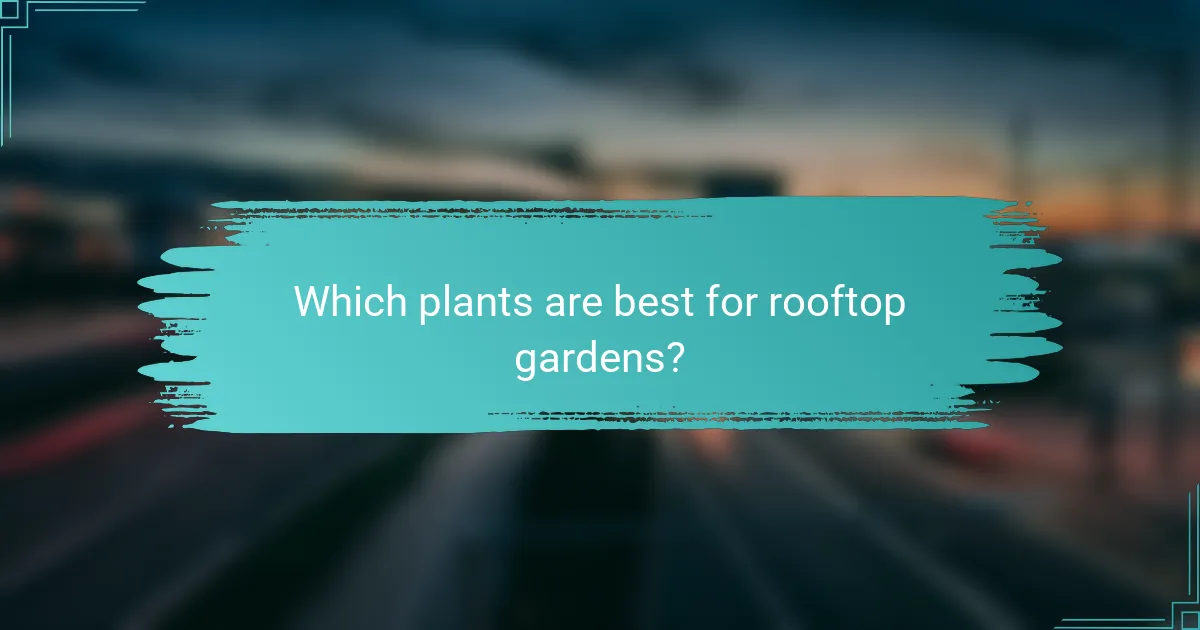
Which plants are best for rooftop gardens?
Rooftop gardens thrive with plants that can adapt to limited space and varying weather conditions. Selecting the right plants enhances aesthetics and maximizes the utility of your rooftop space.
Herbs like basil and mint
Herbs such as basil and mint are ideal for rooftop gardens due to their compact growth and versatility. They require minimal space and can thrive in containers, making them perfect for urban settings.
When planting herbs, ensure they receive at least six hours of sunlight daily. Regular watering and well-draining soil will help maintain their health and flavor.
Vegetables such as tomatoes and peppers
Vegetables like tomatoes and peppers are excellent choices for rooftop gardens, offering both beauty and utility. These plants can grow well in pots and benefit from the warmth of the rooftop environment.
Choose dwarf or determinate varieties for limited space, and ensure they have sturdy support as they grow. Regular feeding with a balanced fertilizer can boost yields significantly.
Flowers like petunias and geraniums
Flowers such as petunias and geraniums add vibrant color and visual appeal to rooftop gardens. They are generally hardy and can tolerate the conditions found on rooftops, including wind and sun exposure.
Plant these flowers in well-draining soil and deadhead regularly to encourage blooming. Consider mixing different colors and varieties to create an eye-catching display throughout the growing season.
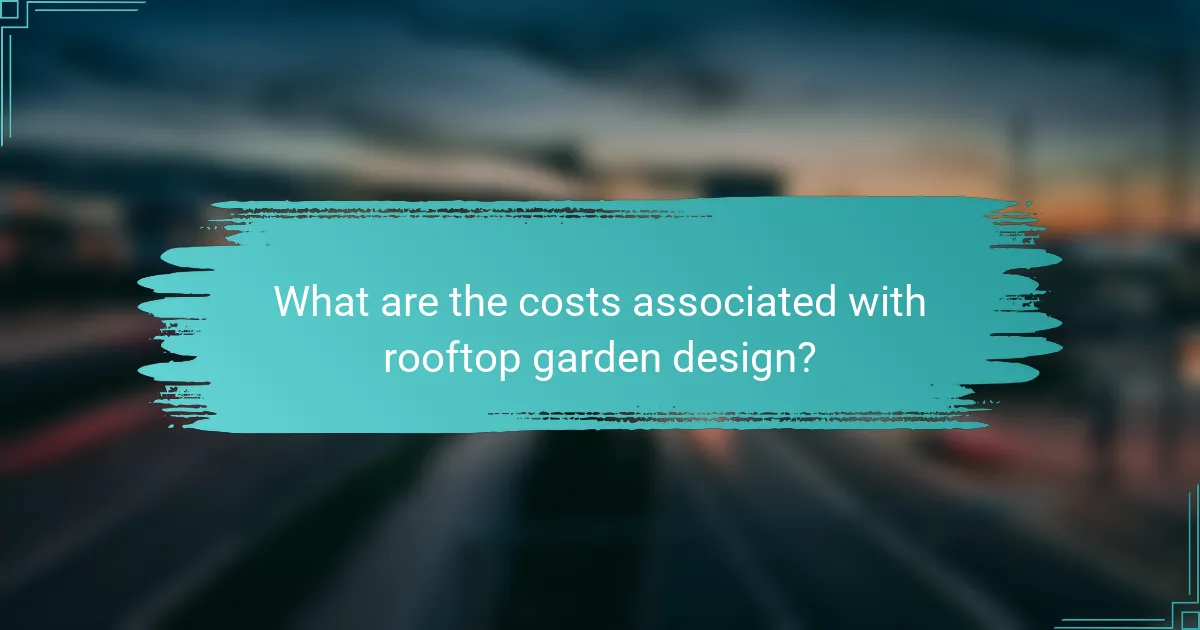
What are the costs associated with rooftop garden design?
The costs of rooftop garden design can vary significantly based on factors such as size, materials, and plant selection. Understanding both initial setup costs and ongoing maintenance expenses is crucial for effective budgeting.
Initial setup costs
Initial setup costs for a rooftop garden typically include materials, labor, and design fees. Depending on the complexity of the design and the size of the space, these costs can range from a few thousand to tens of thousands of dollars.
Key components to consider are the structural modifications needed to support the garden, waterproofing, soil, plants, and irrigation systems. For example, a simple container garden may cost less than a full-fledged green roof with integrated drainage and irrigation.
Ongoing maintenance expenses
Ongoing maintenance expenses are essential to keep the rooftop garden thriving. These costs can include watering, fertilizing, pruning, and pest management, which may average around a few hundred to a couple of thousand dollars annually, depending on the garden’s size and complexity.
Regular maintenance is crucial for plant health and aesthetic appeal. Hiring a professional gardening service can add to costs, but it ensures that the garden remains in optimal condition. DIY maintenance can save money but requires time and knowledge.
Potential return on investment
Investing in a rooftop garden can yield significant returns, both financially and environmentally. Benefits include increased property value, energy savings through improved insulation, and potential tax incentives for green building practices.
While the initial investment may be substantial, many property owners find that the long-term savings on energy bills and the enhanced marketability of their property justify the costs. Additionally, a well-maintained rooftop garden can provide a unique selling point in urban real estate markets.
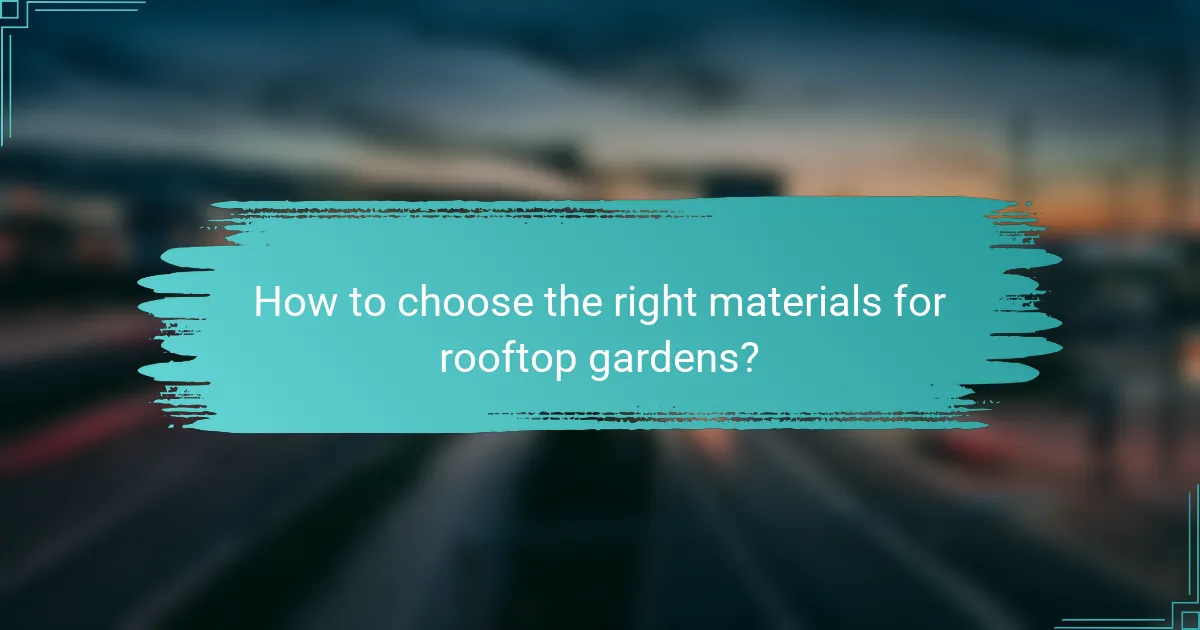
How to choose the right materials for rooftop gardens?
Selecting the right materials for rooftop gardens is crucial for ensuring durability, safety, and aesthetic appeal. Consider factors such as weight, weather resistance, and sustainability to create a thriving garden environment.
Assess weight limitations
Before starting a rooftop garden, evaluate the structural weight capacity of your building. Most rooftops can support a load of around 15-20 pounds per square foot, but this can vary based on local building codes and the age of the structure.
Choose lightweight materials such as modular planters, lightweight soil mixes, and vertical gardening systems to maximize plant growth without exceeding weight limits. Avoid heavy stone or concrete materials unless you have confirmed that your roof can support them.
Consider weather resistance
Rooftop gardens are exposed to harsh weather conditions, including strong winds, intense sunlight, and heavy rain. Select materials that can withstand these elements, such as UV-resistant fabrics for shade structures and rust-resistant metals for planters.
Incorporate drainage systems to prevent water accumulation, which can damage both plants and the building structure. Using weather-resistant coatings on wooden elements can also prolong their lifespan in outdoor conditions.
Evaluate sustainability options
Opt for eco-friendly materials that promote sustainability in your rooftop garden. Consider using recycled plastics for planters, organic soil amendments, and native plants that require less water and maintenance.
Implementing a rainwater harvesting system can also enhance sustainability by reducing water usage. Look for local suppliers who offer sustainable materials to support your garden while minimizing your environmental impact.
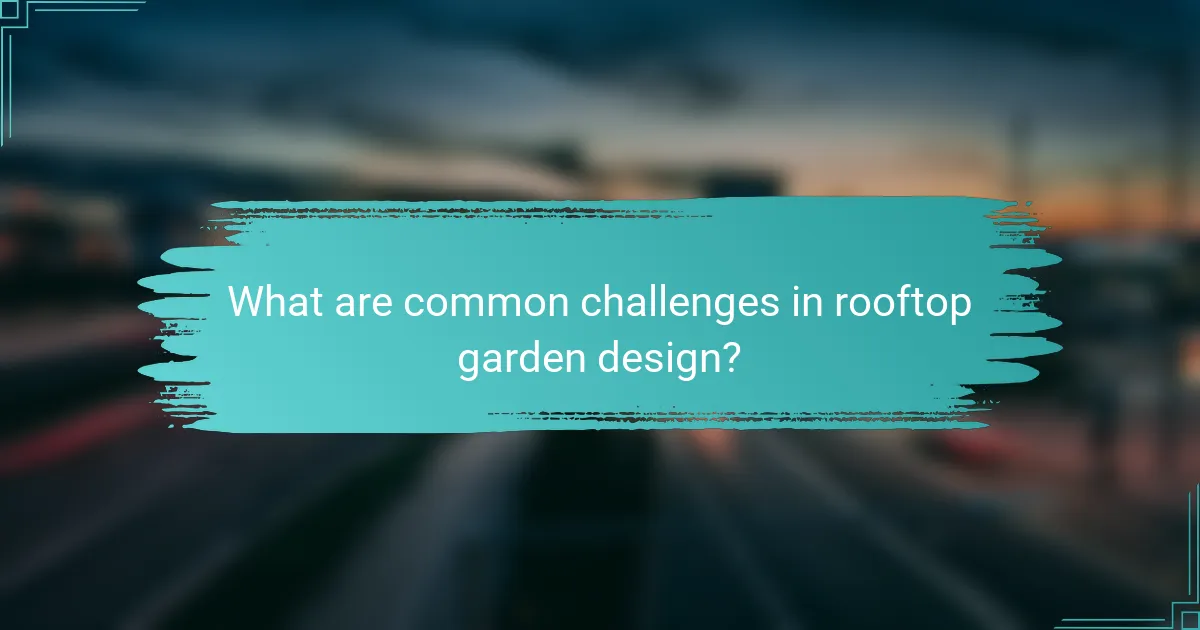
What are common challenges in rooftop garden design?
Rooftop garden design presents several challenges, including limited space, exposure to elements, and plant selection. Addressing these issues is crucial for creating a thriving garden that maximizes both aesthetics and functionality.
Limited sunlight exposure
Limited sunlight exposure is a significant challenge for rooftop gardens, as buildings and surrounding structures can cast shadows. This can restrict the amount of direct sunlight plants receive, impacting their growth and health.
To mitigate this issue, consider the orientation of your rooftop. South-facing roofs typically receive the most sunlight, while north-facing areas may struggle. Using reflective materials or strategically placing taller plants can help maximize light exposure for shorter plants.
When selecting plants, choose varieties that thrive in partial shade or low-light conditions. Herbs like mint and parsley, as well as shade-tolerant flowers such as impatiens, can flourish in these environments. Regularly monitor plant health and adjust positioning as needed to ensure optimal growth.
